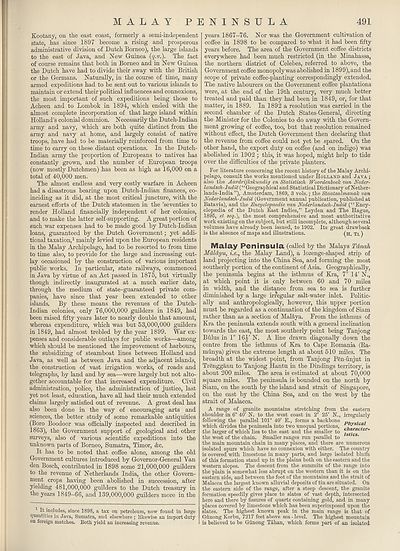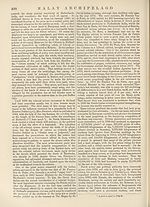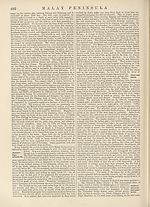New volumes of the Encyclopædia Britannica > Volume 30, K-MOR
(521) Page 491
Download files
Complete book:
Individual page:
Thumbnail gallery: Grid view | List view

491
MALAY PENINSULA
Kootany, on the east coast, formerly a semi-independent
state, has since 1897 become a rising and prosperous
administrative division of Dutch Borneo), the large islands
to the east of Java, and New Guinea (y.'U.). The fact
of course remains that both in Borneo and in New Guinea
the Dutch have had to divide their sway with the British
or the Germans. Naturally, in the course of time, many
armed expeditions had to be sent out to various islands to
maintain or extend their political influences and connexions,
the most important of such expeditions being those to
Acheen and to Lombok in 1894, which ended with the
almost complete incorporation of that large island within
Holland’s colonial dominion. Necessarily the Dutch-Indian
army and navy, which are both quite distinct from the
army and navy at home, and largely consist of native
troops, have had to be materially reinforced from time to
time to carry on these distant operations. In the Dutch-
Indian army the proportion of Europeans to natives has
constantly grown, and the number of European troops
(now mostly Dutchmen) has been as high as 16,000 on a
total of 40,000 men.
The almost endless and very costly warfare in Acheen
had a disastrous bearing upon Dutch-Indian finances, co¬
inciding as it did, at the most critical juncture, with the
earnest efforts of the Dutch statesmen in the ’seventies to
render Holland financially independent of her colonies,
and to make the latter self-supporting. A great portion of
such war expenses had to be made good by Dutch-Indian
loans, guaranteed by the Dutch Government; yet addi¬
tional taxation,1 mainly levied upon the European residents
in the Malay Archipelago, had to be resorted to from time
to time also, to provide for the large and increasing out¬
lay occasioned by the construction of various important
public works. In particular, state railways, commenced
in Java by virtue of an Act passed in 1875, but virtually
though indirectly inaugurated at a much earlier date,
through the medium of state-guaranteed private com¬
panies, have since that year been extended to other
islands. By these means the revenues of the Dutch-
Indian colonies, only 76,000,000 guilders in 1849, had
been raised fifty years later to nearly double that amount,
whereas expenditure, which was but 53,000,000 guilders
in 1849, had almost trebled by the year 1899. War ex¬
penses and considerable outlays for public works—among
which should be mentioned the improvement of harbours,
the subsidizing of steamboat lines between Holland and
Java, as well as between Java and the adjacent islands,
the construction of vast irrigation works, of roads and
telegraphs, by land and by sea—were largely but not alto¬
gether accountable for that increased expenditure. Civil
administration, police, the administration of justice, last
yet not least, education, have all had their much extended
claims largely satisfied out of revenue. A great deal has
also been done in the way of encouraging arts and
sciences, the better study of some remarkable antiquities
(Boro Boodoor was officially inspected and described in
1863), the Government support of geological and other
surveys, also of various scientific expeditions into the
unknown parts of Borneo, Sumatra, Timor, &c.
It has to be noted that coffee alone, among the old
Government cultures introduced by Governor-General Van
den Bosch, contributed in 1898 some 21,000,000 guilders
to the revenue of Netherlands India, the other Govern¬
ment crops having been abolished in succession, after
yielding 481,000,000 guilders to the Dutch treasury in
the years 1849-66, and 139,000,000 guilders more in the
It includes, since 1898, a tax on petroleum, now found in large
quantities in Java, Sumatra, and elsewhere ; likewise an import duty
on foreign matches. Both yield an increasing revenue.
years 1867-76. Nor was the Government cultivation of
coffee in 1898 to be compared to what it had been fifty
years before. The area of the Government coffee districts
everywhere had been much restricted (in the Minahassa,
the northern district of Celebes, referred to above, the
Government coffee monopoly was abolished in 1899), and the
scope of private coffee-planting correspondingly extended.
The native labourers on the Government coffee plantations
were, at the end of the 19 th century, very much better
treated and paid than they had been in 1849, or, for that
matter, in 1889. In 1892 a resolution was carried in the
second chamber of the Dutch States-General, directing
the Minister for the Colonies to do away with the Govern¬
ment growing of coffee, too, but that resolution remained
without effect, the Dutch Government then declaring that
the revenue from coffee could not yet be spared. On the
other hand, the export duty on coffee (and on indigo) was
abolished in 1902 ; this, it was hoped, might help to tide
over the difficulties of the private planters.
For literature concerning the recent history of the Malay Archi¬
pelago, consult the works mentioned under Holland and Java ;
also the Aardrijkskundig en Statistisch Woordenboek van Nedcr-
(“Geographical and Statistical Dictionary of Nether-
lands-India ”), Amsterdam, 1869, 3 vols.; the Staatsalmanak van
JVederlandsch-Indie (Government annual publication, published at
Batavia), and the Encyclopaedic van Nederlandsch-Indie (‘ ‘ Ency¬
clopaedia of the Dutch East Indies,” Leyden and The Hague,
1895, et seq.), the most comprehensive and most authoritative
work existing on the subject, but still incomplete, although several
volumes have already been issued, to 1902. Its great drawback
is the absence of maps and illustrations. (h. Ti. )
Malay Peninsula (called by the Malays Tdnah
Mdldyu, i.e., the Malay Land), a lozenge-shaped strip of
land projecting into the China Sea, and forming the most
southerly portion of the continent of Asia. Geographically,
the peninsula begins at the isthmus of Kra, 7° 14' N.,
at which point it is only between 60 and 70 miles
in width, and the distance from sea to sea is further
diminished by a large irregular salt-water inlet. Politic¬
ally and anthropologically, however, this upper portion
must be regarded as a continuation of the kingdom of Siam
rather than as a section of Malaya. From the isthmus of
Kra the peninsula extends south with a general inclination
towards the east, the most southerly point being Tanjong
Bulus in 1° 16|' N. A line drawn diagonally down the
centre from the isthmus of Kra to Cape Romania (Ra-
munya) gives the extreme length at about 510 miles. The
breadth at the widest point, from Tanjong Pen-unjut in
Trgngganu to Tanjong Hantu in the Dindings territory, is
about 200 miles. The area is estimated at about 70,000
square miles. The peninsula is bounded on the north by
Siam, on the south by the island and strait of Singapore,
on the east by the China Sea, and on the west by the
strait of Malacca.
A range of granite mountains stretching from the eastern
shoulder in 6° 40' N. to the west coast in 2° 25' N., irregularly
following the parallel 101° 40' E., forms a backbone p. , .
which divides the peninsula into two unequal portions, r
the larger of which lies to the east and the smaller to ysl»yc^C C
the west of the chain. Smaller ranges run parallel to
the main mountain chain in many places, and there are numerous
isolated spurs which have no connexion with either. The country
is covered with limestone in many parts, and large isolated bluffs
of this formation stand up in the plains both on the eastern and the
western slopes. The descent from the summits of the range into
the plain is somewhat less abrupt on the western than it is on the
eastern side, and between the foot of the mountains and the strait of
Malacca the largest known alluvial deposits of tin are situated. On
the eastern side of the range, after a steep descent, the granite
formation speedily gives place to slates of vast depth, intersected
here and there by fissures of quartz containing gold, and in many
places covered by limestone which has been superimposed upon the
slates. The highest known peak in the main range is that of
Gfinong Korbu, 7217 feet above sea-level. The highest mountain
is believed to be Gunong Tahan, which forms part of an isolated
MALAY PENINSULA
Kootany, on the east coast, formerly a semi-independent
state, has since 1897 become a rising and prosperous
administrative division of Dutch Borneo), the large islands
to the east of Java, and New Guinea (y.'U.). The fact
of course remains that both in Borneo and in New Guinea
the Dutch have had to divide their sway with the British
or the Germans. Naturally, in the course of time, many
armed expeditions had to be sent out to various islands to
maintain or extend their political influences and connexions,
the most important of such expeditions being those to
Acheen and to Lombok in 1894, which ended with the
almost complete incorporation of that large island within
Holland’s colonial dominion. Necessarily the Dutch-Indian
army and navy, which are both quite distinct from the
army and navy at home, and largely consist of native
troops, have had to be materially reinforced from time to
time to carry on these distant operations. In the Dutch-
Indian army the proportion of Europeans to natives has
constantly grown, and the number of European troops
(now mostly Dutchmen) has been as high as 16,000 on a
total of 40,000 men.
The almost endless and very costly warfare in Acheen
had a disastrous bearing upon Dutch-Indian finances, co¬
inciding as it did, at the most critical juncture, with the
earnest efforts of the Dutch statesmen in the ’seventies to
render Holland financially independent of her colonies,
and to make the latter self-supporting. A great portion of
such war expenses had to be made good by Dutch-Indian
loans, guaranteed by the Dutch Government; yet addi¬
tional taxation,1 mainly levied upon the European residents
in the Malay Archipelago, had to be resorted to from time
to time also, to provide for the large and increasing out¬
lay occasioned by the construction of various important
public works. In particular, state railways, commenced
in Java by virtue of an Act passed in 1875, but virtually
though indirectly inaugurated at a much earlier date,
through the medium of state-guaranteed private com¬
panies, have since that year been extended to other
islands. By these means the revenues of the Dutch-
Indian colonies, only 76,000,000 guilders in 1849, had
been raised fifty years later to nearly double that amount,
whereas expenditure, which was but 53,000,000 guilders
in 1849, had almost trebled by the year 1899. War ex¬
penses and considerable outlays for public works—among
which should be mentioned the improvement of harbours,
the subsidizing of steamboat lines between Holland and
Java, as well as between Java and the adjacent islands,
the construction of vast irrigation works, of roads and
telegraphs, by land and by sea—were largely but not alto¬
gether accountable for that increased expenditure. Civil
administration, police, the administration of justice, last
yet not least, education, have all had their much extended
claims largely satisfied out of revenue. A great deal has
also been done in the way of encouraging arts and
sciences, the better study of some remarkable antiquities
(Boro Boodoor was officially inspected and described in
1863), the Government support of geological and other
surveys, also of various scientific expeditions into the
unknown parts of Borneo, Sumatra, Timor, &c.
It has to be noted that coffee alone, among the old
Government cultures introduced by Governor-General Van
den Bosch, contributed in 1898 some 21,000,000 guilders
to the revenue of Netherlands India, the other Govern¬
ment crops having been abolished in succession, after
yielding 481,000,000 guilders to the Dutch treasury in
the years 1849-66, and 139,000,000 guilders more in the
It includes, since 1898, a tax on petroleum, now found in large
quantities in Java, Sumatra, and elsewhere ; likewise an import duty
on foreign matches. Both yield an increasing revenue.
years 1867-76. Nor was the Government cultivation of
coffee in 1898 to be compared to what it had been fifty
years before. The area of the Government coffee districts
everywhere had been much restricted (in the Minahassa,
the northern district of Celebes, referred to above, the
Government coffee monopoly was abolished in 1899), and the
scope of private coffee-planting correspondingly extended.
The native labourers on the Government coffee plantations
were, at the end of the 19 th century, very much better
treated and paid than they had been in 1849, or, for that
matter, in 1889. In 1892 a resolution was carried in the
second chamber of the Dutch States-General, directing
the Minister for the Colonies to do away with the Govern¬
ment growing of coffee, too, but that resolution remained
without effect, the Dutch Government then declaring that
the revenue from coffee could not yet be spared. On the
other hand, the export duty on coffee (and on indigo) was
abolished in 1902 ; this, it was hoped, might help to tide
over the difficulties of the private planters.
For literature concerning the recent history of the Malay Archi¬
pelago, consult the works mentioned under Holland and Java ;
also the Aardrijkskundig en Statistisch Woordenboek van Nedcr-
(“Geographical and Statistical Dictionary of Nether-
lands-India ”), Amsterdam, 1869, 3 vols.; the Staatsalmanak van
JVederlandsch-Indie (Government annual publication, published at
Batavia), and the Encyclopaedic van Nederlandsch-Indie (‘ ‘ Ency¬
clopaedia of the Dutch East Indies,” Leyden and The Hague,
1895, et seq.), the most comprehensive and most authoritative
work existing on the subject, but still incomplete, although several
volumes have already been issued, to 1902. Its great drawback
is the absence of maps and illustrations. (h. Ti. )
Malay Peninsula (called by the Malays Tdnah
Mdldyu, i.e., the Malay Land), a lozenge-shaped strip of
land projecting into the China Sea, and forming the most
southerly portion of the continent of Asia. Geographically,
the peninsula begins at the isthmus of Kra, 7° 14' N.,
at which point it is only between 60 and 70 miles
in width, and the distance from sea to sea is further
diminished by a large irregular salt-water inlet. Politic¬
ally and anthropologically, however, this upper portion
must be regarded as a continuation of the kingdom of Siam
rather than as a section of Malaya. From the isthmus of
Kra the peninsula extends south with a general inclination
towards the east, the most southerly point being Tanjong
Bulus in 1° 16|' N. A line drawn diagonally down the
centre from the isthmus of Kra to Cape Romania (Ra-
munya) gives the extreme length at about 510 miles. The
breadth at the widest point, from Tanjong Pen-unjut in
Trgngganu to Tanjong Hantu in the Dindings territory, is
about 200 miles. The area is estimated at about 70,000
square miles. The peninsula is bounded on the north by
Siam, on the south by the island and strait of Singapore,
on the east by the China Sea, and on the west by the
strait of Malacca.
A range of granite mountains stretching from the eastern
shoulder in 6° 40' N. to the west coast in 2° 25' N., irregularly
following the parallel 101° 40' E., forms a backbone p. , .
which divides the peninsula into two unequal portions, r
the larger of which lies to the east and the smaller to ysl»yc^C C
the west of the chain. Smaller ranges run parallel to
the main mountain chain in many places, and there are numerous
isolated spurs which have no connexion with either. The country
is covered with limestone in many parts, and large isolated bluffs
of this formation stand up in the plains both on the eastern and the
western slopes. The descent from the summits of the range into
the plain is somewhat less abrupt on the western than it is on the
eastern side, and between the foot of the mountains and the strait of
Malacca the largest known alluvial deposits of tin are situated. On
the eastern side of the range, after a steep descent, the granite
formation speedily gives place to slates of vast depth, intersected
here and there by fissures of quartz containing gold, and in many
places covered by limestone which has been superimposed upon the
slates. The highest known peak in the main range is that of
Gfinong Korbu, 7217 feet above sea-level. The highest mountain
is believed to be Gunong Tahan, which forms part of an isolated
Set display mode to:
![]() Universal Viewer |
Universal Viewer | ![]() Mirador |
Large image | Transcription
Mirador |
Large image | Transcription
Images and transcriptions on this page, including medium image downloads, may be used under the Creative Commons Attribution 4.0 International Licence unless otherwise stated. ![]()
| Encyclopaedia Britannica > New volumes of the Encyclopædia Britannica > Volume 30, K-MOR > (521) Page 491 |
|---|
| Permanent URL | https://digital.nls.uk/193574274 |
|---|
| Attribution and copyright: |
|
|---|---|
| Shelfmark | EB.18 |
|---|---|
| Description | Ten editions of 'Encyclopaedia Britannica', issued from 1768-1903, in 231 volumes. Originally issued in 100 weekly parts (3 volumes) between 1768 and 1771 by publishers: Colin Macfarquhar and Andrew Bell (Edinburgh); editor: William Smellie: engraver: Andrew Bell. Expanded editions in the 19th century featured more volumes and contributions from leading experts in their fields. Managed and published in Edinburgh up to the 9th edition (25 volumes, from 1875-1889); the 10th edition (1902-1903) re-issued the 9th edition, with 11 supplementary volumes. |
|---|---|
| Additional NLS resources: |
|

